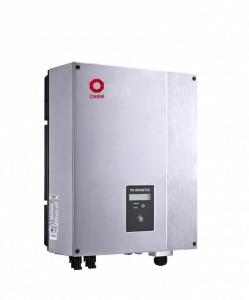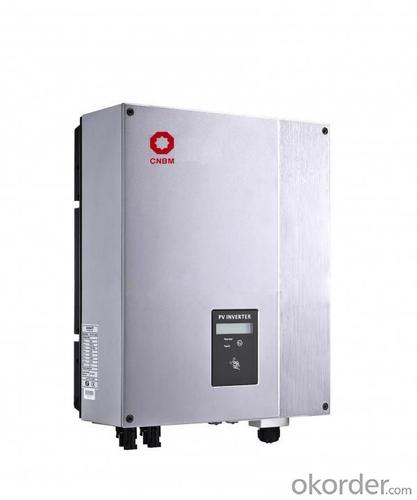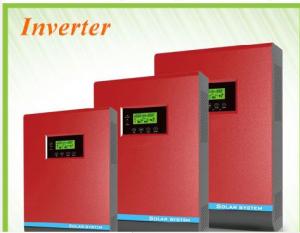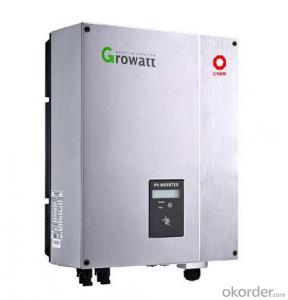12 Volt Solar Inverter CNBM-5000MTL Grid Tied Solar Inverter
- Loading Port:
- Shenzhen
- Payment Terms:
- TT or LC
- Min Order Qty:
- 1 unit pc
- Supply Capability:
- 5000Units/per month pc/month
OKorder Service Pledge
OKorder Financial Service
You Might Also Like
Features of Grid Tied Solar Inverter CNBM-5000MTL
CNBM-5000MTL is a good chice with cost performance solar inverter with 97.9% effciency.
Maximum efficiency of 97.8% and wide input voltage range,
Internal DCswitch,MTL-String,
Sound control,
Bluetooth/RF technology /Wi-Fi
Transformerless,GT topology
With a R&D team more than 100 engineers,40% of the staff, who has been deeply engaged in the photovoltaic industry for 10 years, CNBM takes the mission to increase the inverter availability and efficiency, putting continuous innovation to make CNBM inverter easier for installation and operation, and more cost-effective for solar plant construction.The full range of CNBM single phase inverters has received VDE, CE, G83/1, G59/2, ENEL2010, VDE4105, C10/C11, AS4777 etc.
Technical data of Grid Tied Solar Inverter CNBM-5000MTL
Model | CNBM-4600MTL | CNBM-5000MTL | |
Input data (DC) |
|
| |
Max. DC power | 4800W | 5200W | |
Max. DC voltage | 600V | 600V | |
Start voltage | 150V | 150V | |
PV voltage range | 100V-600V | 100V-600V | |
Max. input current | 15A | 15A | |
Number of MPP trackers /strings per MPP tracker | 2/2 | 2/2 | |
Output (AC) |
| ||
Rated AC output power | 4600W | 5000W | |
Max. AC power | 4600W | 5000W | |
Max. output current | 23A | 25A | |
Power factor | 1 | 1 | |
THDI | <3% | <3% | |
AC connection | Single phase | Single phase | |
Efficiency |
| ||
Max. efficiency | 97.9% | 97.9% | |
Euro weighted efficiency | 97.4% | 97.4% | |
MPPT efficiency | 99.5% | 99.5% | |
Protection devices |
| ||
Output over voltage protection-varistor | yes | yes | |
Ground fault monitoring | yes | yes | |
Grid monitoring | yes | yes | |
General Data |
| ||
Dimensions (W / H / D) in mm | 360/510/188 | 360/510/188 | |
Weight | 24KG | 24KG | |
Operating temperature range | –25°C ... +60°C | –25°C ... +60°C | |
Altitude | 2000m(6560ft) without derating | ||
Self-Consumption night | < 0.5 W | < 0.5 W | |
Topology | Transformerless | ||
Cooling concept | Natural | Natural | |
Environmental Protection Rating | IP65 | IP65 | |
Features |
| ||
DC connection | H4/MC4(opt) | H4/MC4(opt) | |
Display | LCD | LCD | |
Interfaces: RS485/RS232/Bluetooth / RF/Zigbee/Wifi | yes/yes/opt/opt/opt | ||
Warranty: 5 years / 10 years | yes /opt | ||
Certificates and approvals | CE、VDE 0126-1-1、DK5940、G83/1-1、G59/2、RD1663、EN50438、 VDE-AR-N4105、CEI-021、IEC-62109、ENEL-Guide | ||
CNBM-5000MTL is simple national setting of line supply monitoring, Easy country configuration, with Multi-language,display, currently available for most of the countries over the world.With technical creativity and scientific management, the factory established first class R&D and test centers, as well as management and R&D teams comprising of PhDs and masters with overseas qualification.
Figure 1 the test of Grid Tied Solar Inverter CNBM-5000MTL
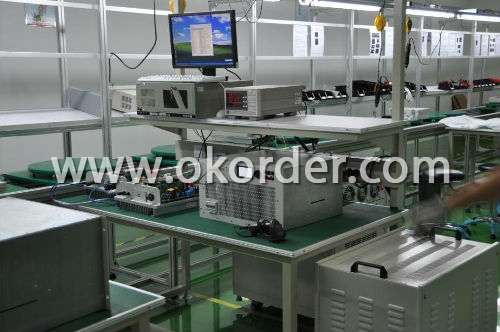
Figure 2 The production of Grid Tied Solar Inverter CNBM-5000MTL
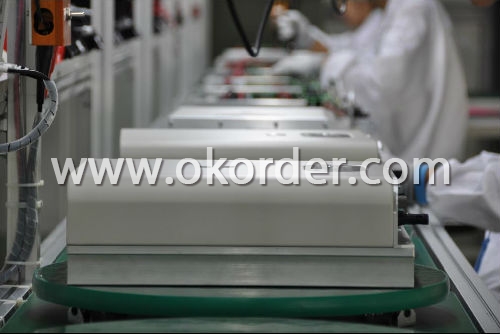
- Q: What is the role of anti-islanding protection in a solar inverter?
- The role of anti-islanding protection in a solar inverter is to ensure the safety of utility workers and prevent damage to the electrical grid in the event of a power outage. It detects when the grid goes down and immediately shuts off the solar inverter, preventing it from continuing to generate electricity and potentially sending power back into the grid. This feature is essential to avoid the risk of electricity flowing into the grid, which could pose a danger to technicians working on power lines and disrupt the stability of the electrical system.
- Q: What are the different types of solar inverters?
- There are three main types of solar inverters: string inverters, microinverters, and power optimizers.
- Q: What is the role of a power limiter in a solar inverter system?
- The role of a power limiter in a solar inverter system is to regulate the amount of power that is fed into the grid from the solar panels. Solar panels generate electricity based on the available sunlight, and at times, they may produce more power than what is needed or allowed by the grid. In such cases, a power limiter acts as a control mechanism to limit the amount of power that can be injected into the grid. It ensures that the power output from the solar panels remains within the specified limits, preventing overloading or destabilization of the grid. The power limiter continuously monitors the power output from the solar panels and adjusts it accordingly to match the grid requirements. It does this by intelligently controlling the inverter, which converts the direct current (DC) generated by the solar panels into alternating current (AC) suitable for grid integration. By limiting the power fed into the grid, a power limiter helps in maintaining grid stability, preventing voltage fluctuations, and minimizing the risk of power surges or blackouts. It also ensures compliance with local regulations and grid codes related to solar power generation. Additionally, a power limiter can provide additional functionalities such as grid synchronization, anti-islanding protection, and remote monitoring. These features enhance the safety, reliability, and overall performance of the solar inverter system. Overall, the presence of a power limiter in a solar inverter system is crucial for maintaining a balance between power generation and grid stability, optimizing the utilization of solar energy, and ensuring a safe and efficient integration of solar power into the electrical grid.
- Q: What is the typical installation process for a solar inverter?
- The typical installation process for a solar inverter involves several steps. First, the inverter is mounted in a suitable location, usually close to the solar panels and near the electrical service panel. Then, the DC input wires from the solar panels are connected to the DC input terminals on the inverter. The AC output terminals of the inverter are then connected to the electrical service panel, allowing the generated electricity to be fed into the grid or used by the household. Finally, the inverter is connected to a monitoring system, which enables the user to track the performance and energy production of the solar system. It is important to note that the installation process may vary depending on the specific inverter model and the local electrical codes and regulations.
- Q: Can a solar inverter be used with battery storage?
- Yes, a solar inverter can be used with battery storage. In fact, integrating a solar inverter with battery storage systems allows for storing excess solar energy generated during the day and using it at night or during times of high energy demand. This combination enables greater energy independence and the ability to use renewable energy even when the sun is not shining.
- Q: How does a solar inverter handle grid synchronization during startup?
- During startup, a solar inverter handles grid synchronization by first ensuring that the grid is stable and within acceptable voltage and frequency ranges. It then synchronizes its output voltage and frequency with the grid by monitoring its phase angle and adjusting it accordingly. This synchronization process allows the solar inverter to safely and seamlessly connect to the grid, ensuring smooth power transfer and operation.
- Q: Can a solar inverter be used with different types of grid support functions?
- Yes, a solar inverter can be used with different types of grid support functions. Solar inverters are designed to convert the direct current (DC) power generated by solar panels into alternating current (AC) power that can be used in homes or fed back into the grid. They can also have additional functionalities to support the grid, such as reactive power control, voltage regulation, frequency control, and anti-islanding protection. These grid support functions allow solar inverters to effectively integrate renewable energy into the existing power grid infrastructure.
- Q: Can a solar inverter be used in regions with high temperature extremes?
- Yes, solar inverters can be used in regions with high temperature extremes. However, it is important to choose inverters that are specifically designed to handle such conditions, as excessive heat can affect their performance and lifespan. These inverters should have features like advanced thermal management systems, wide temperature operating ranges, and robust cooling mechanisms to ensure optimal functioning and durability even in extreme temperatures.
- Q: What is the maximum operating temperature of a solar inverter?
- The maximum operating temperature of a solar inverter typically ranges between 40 to 50 degrees Celsius, depending on the specific model and manufacturer.
- Q: Can a solar inverter be used with a grid-interactive system?
- Yes, a solar inverter can be used with a grid-interactive system. In fact, a solar inverter is an essential component of a grid-interactive system as it converts the DC (direct current) electricity produced by solar panels into AC (alternating current) electricity that can be used to power homes or businesses and also fed back into the grid. The solar inverter also manages the flow of electricity between the solar panels, batteries (if present), and the grid, ensuring efficient and safe operation of the grid-interactive system.
Send your message to us
12 Volt Solar Inverter CNBM-5000MTL Grid Tied Solar Inverter
- Loading Port:
- Shenzhen
- Payment Terms:
- TT or LC
- Min Order Qty:
- 1 unit pc
- Supply Capability:
- 5000Units/per month pc/month
OKorder Service Pledge
OKorder Financial Service
Similar products
Hot products
Hot Searches
Related keywords
